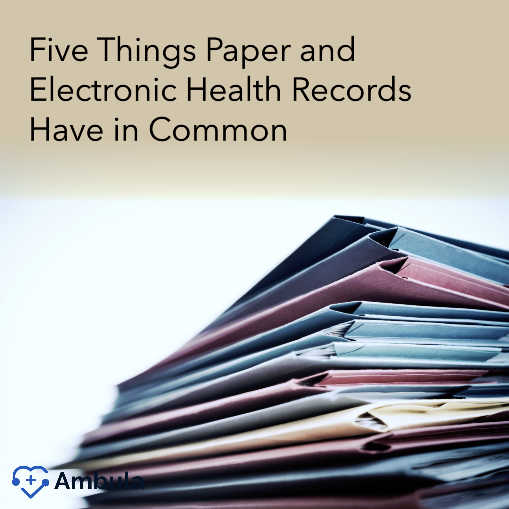
Healthcare has always been about discovering the secrets of human health and restoring patients to their full health potential. In doing so, healthcare practitioners heavily rely on record-keeping systems to track patient’s history, administer treatment, and predict future health concerns. From traditional paper-based records to modern Electronic Health Records (EHRs), the core function of health record-keeping systems remains the same: to effectively tell a patient’s health story. This article delves into the similarities and differences between paper records and EHRs, discussing components like patient information, privacy and confidentiality, transferability, chronological record keeping, and manageability. It also shines a light on the future of healthcare and how EHR, with the help of AI and machine learning, is revolutionizing patient care.
1. Patient Information
Whether you’re flipping through paper-based health records or tapping your way through a digital version, there’s one thing you’re bound to come across – loads of patient information. We’re talking medical history, current medications, allergies, test results, everything! Paper or electronic, the core function of any health record is to tell a patient’s health story.
Now, you’d think that accessing this info would be easier with a digital system. But that’s not necessarily the case. Like paper records, electronic health records need to be easily accessed. Whether it’s available on hand or at the click of a button, accessibility is a must-have for any health record system.
2. Privacy and Confidentiality
Talk about patient records; you’re automatically stepping into the privacy zone. And this holds no matter what the format of the records is. Both paper and electronic records are governed by strict privacy norms like HIPAA, which keeps patient info safe and sound. So, only those with the required authority can view these records.
But it doesn’t just stop at privacy. Health records are also about keeping track of a patient’s journey through various health issues. Both paper and electronic records are like a lookback mechanism that lets healthcare providers follow the breadcrumbs of a patient’s health history. This legacy data helps doctors diagnose accurately and chalk out the future treatment plan.
3. Transferability
Here’s something cool – paper and electronic records can be moved around as needed. When it comes to paper records, you’ve got to put in a little elbow grease and physically move them. But with electronic records, it’s as easy as hitting a button. Sure, the process is much easier and streamlined with electronic records. But at the end of the day, both types let you share the needed info with other providers.
Now, chances are, you’re inclined towards electronic health records because they’re simply more convenient. Easier to read, share, and process – these are all true. But here’s the kicker – with the help of AI and natural language processing, electronic records can provide real-time useful insights that aid in personalized treatments. Such insights are invaluable for improving patient care and assisting doctors in decision-making.
So, while paper records and EHRs have their commonalities, the increased adoption of digital is a clear pointer towards a tech-dominant healthcare future. And as doctors and nurses get the hang of EHR technology and it continues to evolve, we’re certain to see further betterment in patient care. Healthcare systems efficiency is going to get a big, big boost. Keep an eye on this digital revolution!
4. Chronological Record-Keeping
So, you might think that maintaining chronology is only about keeping dates straight. But in health records, it’s much, much more. Both paper and electronic health records capture historical medical documents of patients. They mirror a timeline that stretches from a patient’s first appointment, maybe even since birth, to their last interaction with a healthcare provider.
Health records are a paper (or digital) trail in medical care. Whether a traditionalist or tech-savvy, you might use a paper ledger or an automatic time stamp in an electronic health record system. But the goal is the same, my friend! Maintain chronological order to keep track of treatment plans and patients’ health progression over the years.
5. Manageability
Next, whether we’re flipping pages or scrolling through screens, manageability is a common factor among paper and electronic health records. You’ve to keep these records clean, don’t you? And by clean, I mean properly organized. We’re talking files, folders, cabinets, and storage rooms for paper records. When it comes to electronic records, it’s about data entry fields, drop-down menus, and cloud storage. Different practices, but all for the same cause: to keep data orderly and at our fingertips.
However, the changing times are telling us a thing or two. We’re leaning more towards digital these days. And why not? Digital records can be read easily and are simpler to transfer and keep organized. When you’ve also got AI and machine learning giving you a hand, it’s hard not to be amazed by the value they add. They extract crucial insights from the digital notes, and that’s just skimming the surface. It’s a big leap forward in making personalized medicine available for everyone.
Summing up, our paper records and EHRs do have their common spaces. But there’s no denying that digital is weaving itself a big spot in the fabric of healthcare. The tech gives us a promising picture of better, efficient patient care. With the systems evolving at such a pace and doctors getting their grips tighter on it, the future sure looks bright! The tech revolution in healthcare is real, and it’s here to stay. Watch this space!



